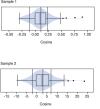Affective Risk Associated With Menstrual Cycle Symptom Change
- PMID: 35936817
- PMCID: PMC9353132
- DOI: 10.3389/fgwh.2022.896924
Affective Risk Associated With Menstrual Cycle Symptom Change
Abstract
In the present study we test whether cyclical changes in affective symptoms of the menstrual cycle are associated with higher mean levels of those same symptoms. Using prospective daily reports across two full menstrual cycles, from two samples of female University students (n = 213; n = 163), we applied both quartic polynomial regressions and cosine regressions to model cyclical change in symptoms, and to test for mean-level differences in symptoms across the resulting trajectory patterns. Counter to prior findings, but consistent with theoretical expectations, these results show that females who experience menstrual cycle-related changes in affect (whether a perimenstrual or mid-cycle increase) are at risk for higher average levels of affective symptoms. These results suggest that the mid-cycle group should be recognized as a target for future research that is associated with increased risk for chronic negative affective symptoms.
Keywords: affective disorders; anxiety; depression; menstrual cycle; risk; women.
Copyright © 2022 Kiesner, Eisenlohr-Moul and Vidotto.
Conflict of interest statement
The authors declare that the research was conducted in the absence of any commercial or financial relationships that could be construed as a potential conflict of interest.
Figures



Similar articles
-
Mid-cycle headaches and their relationship to different patterns of premenstrual stress symptoms.Headache. 2013 Jun;53(6):935-46. doi: 10.1111/head.12082. Epub 2013 Mar 22. Headache. 2013. PMID: 23521540
-
Cumulative stressor exposure predicts menstrual cycle affective changes in a transdiagnostic outpatient sample with past-month suicidal ideation.Psychol Med. 2024 Oct 14;54(13):1-12. doi: 10.1017/S0033291724001661. Online ahead of print. Psychol Med. 2024. PMID: 39397675 Free PMC article.
-
Menstrual cycle-driven vs noncyclical daily changes in sexual desire.J Sex Med. 2023 May 26;20(6):756-765. doi: 10.1093/jsxmed/qdad032. J Sex Med. 2023. PMID: 37037659
-
Perimenstrual symptoms: prevalence and risk factors.Psychosom Med. 1986 Jul-Aug;48(6):388-414. doi: 10.1097/00006842-198607000-00002. Psychosom Med. 1986. PMID: 3529156 Review.
-
Positive perimenstrual changes: toward a new perspective on the menstrual cycle.J Psychosom Res. 1988;32(1):31-40. doi: 10.1016/0022-3999(88)90086-4. J Psychosom Res. 1988. PMID: 3042993 Review.
Cited by
-
Using natural spline models to explore the trajectories of empirically derived domains of premenstrual symptoms.Psychol Assess. 2025 Jan-Feb;37(1-2):33-45. doi: 10.1037/pas0001356. Psychol Assess. 2025. PMID: 39786845
-
Dimensional Affective Sensitivity to Hormones across the Menstrual Cycle (DASH-MC): A transdiagnostic framework for ovarian steroid influences on psychopathology.Mol Psychiatry. 2025 Jan;30(1):251-262. doi: 10.1038/s41380-024-02693-4. Epub 2024 Aug 15. Mol Psychiatry. 2025. PMID: 39143323 Review.
References
-
- Nguyen TV, Reuter JM, Gaikwad NW, Rotroff DM, Kucera HR, Motsinger-Reif A, et al. . The steroid metabolome in women with premenstrual dysphoric disorder during GnRH agonist-induced ovarian suppression: effects of estradiol and progesterone addback. Transl Psychiatry. (2017) 7:e1193. 10.1038/tp.2017.146 - DOI - PMC - PubMed
LinkOut - more resources
Full Text Sources

